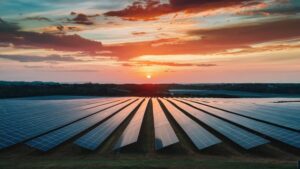Community solar keeps growing. Here’s what we still have to figure out


Summit Ridge Energy developed the 2.495 MW Speedway Solar project 10 miles south of Joliet, Ill. The project is the 75th community solar farm in ComEd’s Northern Illinois service territory. (Courtesy: Summit Ridge Energy)
Episode 74 of the Factor This! podcast features Bruce Stewart, the CEO of community solar subscriber management platform Perch Energy. Subscribe wherever you get your podcasts.
By all accounts, community solar looks like an unstoppable force. One of the hottest clean energy sectors continues to flourish thanks to new markets and rich incentives.
But it’s also getting tougher. First-mover states are saturating, fueling intense competition. And those rich incentives? They’re increasingly tied to serving elusive low-income customers often skeptical of promises that are too good to be true.
So what’s in store for community solar in 2024?
Bruce Stewart, CEO of the community solar subscriber management platform Perch Energy, joined the Factor This! podcast from Renewable Energy World to map out new markets on the way this year, the challenge of acquiring, and keeping, low-income customers, and the latest on the highly-anticipated reboot of California’s troubled community solar program.
Community solar projects have been installed in 41 states and Washington, D.C., while 19 states and D.C. have codified programs. According to the Solar Energy Industries Association, 6.2 GW of community solar capacity is installed in the U.S. with New York, Minnesota, and Massachusetts (Florida ranks second in installed community solar capacity, according to a National Renewable Energy Laboratory tracker, but all projects are utility-owned).
California’s community solar reboot
While California leads the nation in solar, its community solar has been ill-fated since being introduced in 2013. Less than 50 MW had been installed by 2022, which developers say is due to rules that make projects infeasible.
Further driving home the point, the Enhanced Community Renewables component of California’s Green Tariff Shared Renewables Program had no projects in operation before Catalyze secured a contract with Southern California Edison for its 3.9 MW Sheep Creek community solar farm in 2023.
But the community solar sector’s watchful eye is once again on California. The California Public Utilities Commission is in the process of outlining a reboot to the construct as required by state law passed in 2022.
“A lot of our clients today that are developers and asset owners are very actively looking at properties and land to be able to develop,” Steward said. “They’re already going with site acquisition, or at least lease options. It’s the right way to play.”
Assembly Bill 2316 directed the CPUC to design a community solar program that pairs solar power with energy storage while emphasizing environmental justice. At least 51% of subscribers must be low-income customers, triggering at least a 40% federal tax credit on solar installations under the federal Inflation Reduction Act. It also requires paying prevailing wages for workers, triggering a separate 30% federal tax credit for storage installations, also under the IRA.
Unlike the utility-scale solar segment, community solar is designed with equity and environmental justice at its core.
In addition to allowing residents and businesses without suitable roofs for solar to take advantage of the benefits of clean energy, community solar also provides savings of 10-20% to subscribers, a portion of which is required to meet low-to-moderate income (LMI) standards.
Acquiring LMI customers, however, is challenging, and expensive, Stewart said. For one, new customers are often wary of the too-good-to-be-true discount on their utility bill. Others may not be willing to navigate the cumbersome system to verify their income.
Securing an offtake agreement with a large commercial customer may cost around $30,000 per megawatt, Stewart said. Those deals typically run through a broker. LMI recruitment runs more than $100,000-200,000 per megawatt. What’s more, project developers can expect a churn rate of 8-10% among traditional residential customers, while the rate of LMI subscribers jumping ship is nearly double.
“That’s part of the learning curve here,” Stewart said. “We’re beginning to get a flavor for how (customers) pay and whether they’re capable of paying.”
Making LMI easier
Perch, which has so far partnered with 146 community solar projects, begins the outreach process nine months ahead of the project commissioning date. That involves digital marketing, partnering with affordable housing facilities and, sometimes, door-to-door education. Those expenses fall on community solar subscriber management firms, like Perch, adding to the imperative to streamline LMI customer verification.
Perch contributed to the Department of Energy’s work to develop the Low-Income Clean Energy Connector, a digital tool that makes community solar with verified savings and strong consumer protections more accessible to households participating in government-run low-income support programs. The tool is initially intended only for Low-Income Home Energy Assistance Program (LIHEAP) recipients. LIHEAP is a Health and Human Services program that assists eligible low-income households with home energy costs.
The connector is about to leave its testing phase and enter its beta phase where it will be piloted in three states: New Mexico, Illinois, and Washington DC. New York, New Jersey, and Colorado are advising the program partners.
This is all in pursuit of the DOE’s National Community Solar Partnership’s goal of bringing $1 billion in electricity bill savings to 5 million customers by 2025.
“That’s a really big number,” Stewart said. “When you hear those kinds of numbers over a two-year timeframe, you’re like, ‘Okay, how is this going to happen?’
“(The tool) completes that picture of an element of trust and ease, which we really need to take a lot of the stickiness out of bringing those customers on board.”




